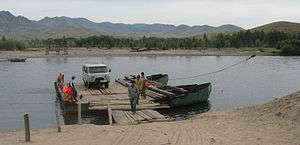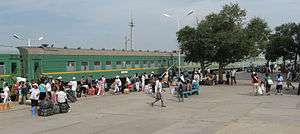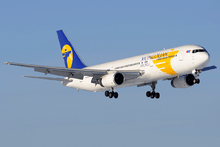Transport in Mongolia
The transportation system in Mongolia consists of a network of railways, roads, waterways, and airports.

Railways

The Trans-Mongolian Railway connects the Trans-Siberian Railway from Ulan Ude in Russia to Erenhot and Beijing in China through the capital Ulaanbaatar. The Mongolian section of this line runs for 1110 km.[1] A spur line connects Darkhan to the copper mines of Erdenet; another spur line connects Ulaanbaatar with the coal mines of Baganuur.
A separate railway line is in the east of the country between Choibalsan and the Trans-Siberian at Borzya; however, that line is closed to passengers beyond the Mongolian town of Chuluunkhoroot.[2] For domestic transport, daily trains run from Ulaanbaatar to Darkhan, Sukhbaatar, and Erdenet, as well as Zamyn-Üüd, Choir and Sainshand. Mongolia uses the 1,520 mm (4 ft 11 27⁄32 in) (Russian gauge) track system. The total length of the system 1,810 km.[3] In 2007, rail transport carried 93% of Mongolian freight and 43% of passenger turnover (in tons*km and passenger*km, respectively).[4]
Roadways
In 2007, only about 2600 km of Mongolia's road network were paved. Another 3900 km are graveled or otherwise improved. This network of paved roads was expanded to 4,800 km in 2013, with 1,800 km completed in 2014 alone.[5] This included the roads from Ulaanbaatar to the Russian and Chinese borders, paved road from Ulaanbaatar to Kharkhorin and Bayankhongor, another going south to Mandalgovi, and a partly parallel road from Lün to Dashinchilen, as well as the road from Darkhan to Bulgan via Erdenet. The vast majority of Mongolia's official road network, some 40,000 km, are simple cross-country tracks.[6][7]
Construction is underway on an east-west road (the so-called Millennium Road) that incorporates the road from Ulaanbaatar to Arvaikheer and on the extension of the Darkhan-Bulgan road beyond Bulgan.[8] Private bus and minibus companies offer service from Ulaanbaatar to most aimag centers.[9]
In September and December 2014 roads connecting Dalanzadgad town of Ömnögovi Province and Mörön town of Khuvsgul province with capital city of Ulaanbaatar were completed.[10]
Bus
Buses are the main mode of public transportation in Ulaanbaatar. There is no set time table, but buses pass stops at approximately 15-minute intervals. Buses runs between 7:00am and 10:00pm. In July 2013, Ulaanbaatar Urban Transport Service with Chinggis Khaan International Airport launched an express bus connecting the airport and downtown area. However, the service was stopped as of September 2013 for unknown period.[11] There is transport between cities of Mongolia offering buses of all sizes from minivans to large coach buses (usually up to 45 seats). The national and municipal governments regulate a wide system of private transit providers which operate numerous bus lines around the city. There is also an Ulaanbaatar trolleybus system. Tenuun Ogoo LLC, Erdem trans LLC and Sutain buyant LLC are the top 3 major private bus operators.
Taxi
There are few licensed taxi companies such as Ulaanbaatar taxi (1991),[12] Noyon taxi (1950),[13] Telecom taxi (1109),[14] 1616 taxi (1616) [15] and iTaxi[16] operating in Ulaanbaatar. There are a few local taxi companies in smaller cities such as Darkhan, Erdenet, Baganuur and Zuunmod. And there are many drivers with private unlicensed cars who act as taxis.
A typical fare is MNT 700-800 per kilometer; taxi drivers tend to ask for more especially if the client is a foreign national. However, many unofficial taxis use the "EasyRide"[17] platform to take orders, which is also available in English. Official taxis with proper markings are allowed to drive without plate number restrictions on the first lane of Ulaanbaatar's central road usually reserved for large public transports such as buses and trolleybuses from October 2013.[18]
Waterways
Mongolia has 580 km of waterways, but only Lake Khövsgöl has ever been heavily used. The Selenge (270 km) and Orkhon (175 km) rivers are navigable but carry little traffic, although a customs boat patrols the Selenge to the Russian border. Lake Khovsgol has charter boats for tourists.[19] The lakes and rivers freeze over in the winter and are usually open between May and September.
Air transportation

As of 2012, most airports of 21 aimag centers of Mongolia have paved runways. Those closest to Ulaanbaatar lack scheduled air service.
Chinggis Khaan International Airport outside of Ulaanbaatar is the major airport in Mongolia that offers international flights. Choibalsan's airport has international status and flights to the Chinese cities of Hailar, Erenhot and Manzhouli.
As of 2013, domestic air carriers such as MIAT Mongolian Airlines, Eznis Airways (unexpectedly suspended its operation on May 22, 2014[20]) Aero Mongolia, Hunnu Air as well as international carriers such as Aeroflot, Korean Air, Air China and Turkish Airlines are offering scheduled services. Domestic airlines except MIAT Mongolian Airlines provide regular service between Ulaanbaatar and aimag centers. Domestic flights are operated using Fokker 50, Airbus 319 and Bombardier Q400 aircraft.
Ulaanbaatar can be accessed with regular flights from major cities such as Moscow, Berlin, Frankfurt, Beijing, Hong Kong, Singapore, Seoul, Tokyo, Osaka (served only in summer), Istanbul and Bishkek.[21]
In 2013 the first purely air cargo operator was registered at the Civil Aviation Authority of Mongolia and is planned to commence operation in 2014.[22]
Talks of a possible restart of flights between the Russian city of Ulan-Ude and Ulaanbaatar by a Russian airline have been reported.[23]
References
- Montsame News Agency. Mongolia. 2006, ISBN 99929-0-627-8, p. 93
- Lonely Planet Mongolia: Choibalsan transport
- Lonely Planet Mongolia: Rail Transport Archived 2012-01-19 at the Wayback Machine
- 2007 Statistical Yearbook of Mongolia, p. 252
- http://ubpost.mongolnews.mn/?p=7086
- "Status paper on Road Sector of Mongolia" Archived 2011-06-07 at the Wayback Machine
- Mongolia's Statistical Yearbook 2007, p.255 Archived 2008-10-10 at the Wayback Machine
- Авто замын салбарт 2007 онд хэрэгжиж байгаа зам, гүүрийн барилга байгууламж, тэсэл арга хэмжээ Archived 2007-09-24 at the Wayback Machine (Powerpoint document, in Mongolian, needs additional fonts to display properly)
- Lonely Planet Mongolia: Bus transport Archived 2012-01-19 at the Wayback Machine
- New airport shuttle bus service launched
- https://www.facebook.com/Ulaanbaatar.Taxi Ulaanbaatar taxi Facebook page
- https://www.youtube.com/watch?v=QxsG6FrmNRs3 Noyon taxi on YouTube
- https://www.youtube.com/watch?v=PnplKPh8nrs Telecom taxi on YouTube
- https://www.youtube.com/watch?v=YXDsOg4MhWI 1616 taxi on YouTube
- [Official website of iTaxi company] "Archived copy". Archived from the original on 2014-12-11. Retrieved 2014-12-11.CS1 maint: archived copy as title (link)
- https://play.google.com/store/apps/details?id=com.mongoapps.taxi "EasyRide" app on Google Play
- "Official taxis to drive on first lane along with other public transport".
- Lonely Planet Mongolia: Boat transport Archived 2012-01-19 at the Wayback Machine
- Mongolian International Transport Directory
- Mongolian First Air Cargo Operator
External links
| Wikimedia Commons has media related to Transport in Mongolia. |